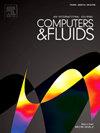高速稀薄气体流的福克-普朗克-DSMC 混合方法评估
IF 2.5
3区 工程技术
Q3 COMPUTER SCIENCE, INTERDISCIPLINARY APPLICATIONS
引用次数: 0
摘要
直接模拟蒙特卡罗(DSMC)方法已被广泛用于稀薄气体流动的模拟。实践证明,DSMC 方法的数值解收敛于玻尔兹曼方程,为高努森数提供了坚实的物理基础。然而,许多航空航天工程问题包括单个域中的低密度和高密度区域,这使得 DSMC 方法的计算成本非常昂贵。在过去的十年中,粒子福克-普朗克(FP)方法一直被作为一种降低连续系统计算成本的方法来研究。在提高效率的同时,FP 方法在高 Knudsen 数时失去了物理精度。为了在整个 Knudsen 数范围内实现普遍的精度和效率,人们研究了 FP-DSMC 混合方法。然而,迄今为止,DSMC、FP 和 FP-DSMC 混合方法之间的一致性比较受到的关注还很有限。本文对 DSMC、FP 和混合 FP-DSMC 方法进行了一致的比较研究,以评估混合 FP-DSMC 方法的准确性和效率。混合 FP-DSMC 求解器是基于开源 SPARTA 框架开发的。基准问题包括平面喷嘴中的超音速流动、围绕圆柱体的高超声速流动以及围绕类似于 THAAD 导弹的高超声速流动。结果表明,FP-DSMC 混合方法比 DSMC 方法更高效,同时比 FP 方法更精确。与收敛后的 DSMC 仿真相比,FP-DSMC 方法的速度提高了 1.5 到 14 倍。本文章由计算机程序翻译,如有差异,请以英文原文为准。
An evaluation of the hybrid Fokker–Planck-DSMC approach for high-speed rarefied gas flows
The Direct Simulation Monte Carlo (DSMC) method has been widely used for simulations of rarefied gas flows. It has been proven that the numerical solution of the DSMC method converges to the Boltzmann equation, providing a solid physical foundation for high Knudsen numbers. However, many aerospace engineering problems include both low and high-density regions in a single domain, making the DSMC method computationally expensive. Over the past decade, the particle Fokker–Planck (FP) method has been studied as a means to reduce computational costs near the continuum regime. While enhancing efficiency, the FP method loses physical accuracy at high Knudsen numbers. Aiming for universal accuracy and efficiency across the whole range of Knudsen numbers, the hybrid FP-DSMC method has been studied. Nevertheless, consistent comparisons among the DSMC, FP, and hybrid FP-DSMC methods have received limited attention so far. This paper presents a consistent comparative study of the DSMC, FP, and hybrid FP-DSMC methods to assess the accuracy and efficiency of the hybrid FP-DSMC method. The hybrid FP-DSMC solver is developed based on the open-source SPARTA framework. The benchmark problems include supersonic flow in a planar nozzle, hypersonic flow around a cylinder, and hypersonic flow around a THAAD-like missile. The results demonstrate that the hybrid FP-DSMC method can be more efficient than the DSMC method while being more accurate than the FP method. The speed-up achieved by the FP-DSMC method ranged from 1.5 to 14 times compared to the converged DSMC simulation.
求助全文
通过发布文献求助,成功后即可免费获取论文全文。
去求助
来源期刊

Computers & Fluids
物理-计算机:跨学科应用
CiteScore
5.30
自引率
7.10%
发文量
242
审稿时长
10.8 months
期刊介绍:
Computers & Fluids is multidisciplinary. The term ''fluid'' is interpreted in the broadest sense. Hydro- and aerodynamics, high-speed and physical gas dynamics, turbulence and flow stability, multiphase flow, rheology, tribology and fluid-structure interaction are all of interest, provided that computer technique plays a significant role in the associated studies or design methodology.
 求助内容:
求助内容: 应助结果提醒方式:
应助结果提醒方式:


